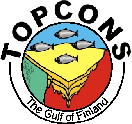Тематика проекта:
- Integrative approach: 1) contact data; 2) satial visualization and modelling; 3) spatial data.
- RAS TOPCONS co-operation: 1) target groups and GOF2014 initiartive; 2) TOPCONS partnership and selected reporting materials.
- RAS TOPCONS field:
SPBRC RAS contribution to TOPCONS visibility actions about field 2013.
The goal of the field season-2013 for SPBRC RAS as the TOPCONS project partner is to provide data on structure and distribution of biotic components, human activities, distribution of indicative hazardous substances’ concentrations in typical biotopes in marine and coastal landscapes in three project model areas on the Russian side of border (Figure 1)
.
The set of collected data will be then used:
(1) to fulfil the gapes in existing information about landscapes and their conservation and spatial planning of human activities therein;
(2) to assess the state of selected biotopes before the expected extensive hydrotechnical works (dredging) starts in project model area-3 (see Figure);
(3) as input for statistical analyses and landscapes mapping and modelling carried out together with other project partners.
The data collection is planned according to integrative approach based on combination of spatial methods (satellite high resolution images’ analyses and verification, underwater video) and “contact methods” - standard simultaneous environmental sampling and measurement, biological sampling and observations across snapshot of stations that covers natural and anthropogenically transformed landscapes. The planned fieldworks will be also a way to cooperate between partners as: (1) sampling facilities, underwater video devices and rented vessels will be shared with VSEGEI; (2) SPBRC RAS expert will join Metsahalitus, SYKE and RKTL cruises and field trips in order to have exchange of biological sampling and observation experience and training in new methods.
SPBRC RAS starts the field season-2013 in mid May after the navigation is opened in order to collect data on breeding of key species of fishes, birds (including red list species), invertebrates and plants, key plants associations in typical biotopes of project model areas 2 (Kurgalsky districts) and 3 (the Neva Bay and Kurortny district) (see Figure) and to provide background data before hydrotechnical works have started. The field surveys will occur as cruises onboard of rented water jet caters able to approach to the coast to the depth of 1-1.5m and as coastal expeditions by car along relatively pristine and anthropogenically transformed coasts aimed to investigate coasts and shallows.
Main efforts will be undertaken in August-September together with other partners across both sides of border as it has been stated at Working Group meeting in February 2013.




